Статьи журнала - Вестник ВолГУ. Серия: История. Регионоведение. Международные отношения
Все статьи: 1645
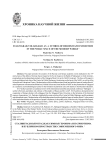
Stalingrad-Volgograd as a symbol of heroism and patriotism in the public space of the modern world
Статья обзорная
The paper presents the analysis of the Russian and foreign academic events dedicated to the 75th anniversary of the defeat of German fascist troops by the Soviet troops in the Battle of Stalingrad, in which lecturers, postgraduate and undergraduate students of the Volgograd State University (VolSU) took part. The focus of the paper is on the multilateral activities of the Center for Public Diplomacy, functioning on the basis of the VolSU, as well as of the Scientific and Educational Center “Modernization of the multidimensional social and political space of modern Russia” at the Department of International Relations, Political Science and Area Studies of VolSU on the presentation of Volgograd as a academic and methodological center for the formation of patriotism and civil identity in the Russian Federation. E.N. Vasilyeva presents an analytical review of the international scientific and practical conference “Stalingrad - a symbol of heroism, patriotism and cohesion of the peoples of Russia and the world”. S.B. Kozhirova characterizes the cooperation of foreign scholars with colleagues from the Volgograd State University on the formation of the historical memory of generations. S.A. Pankratov highlights the main activities of the Center for Public Diplomacy and the academic and educational center “Modernization of the multidimensional social and political space of modern Russia” in the context of the institutionalization of the practices of people’s diplomacy in the public policy of the herocity Volgograd-Stalingrad.
Бесплатно
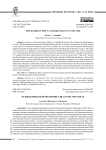
The Kurds in the U.S. Iraqi policy in 1958-1960
Статья научная
Introduction. The article deals with the U.S. Middle East Policy of the Eisenhower Administration in 1958-1960 and determines the part the Kurdish Question played in it. Methods and materials. The study is based on the latest U.S. declassified documents, interviews, memoirs, etc. The author does the problem-chronological analysis to describe the stages of the U.S. Policytoward Iraqi Kurds during the period specified. Analysis. The article is focused on the U.S. diplomatic and intelligence activities aimed at developing approaches to the “communist crisis” and disagreements that arose in the expert community regarding policy decisions. The author considers theU.S. relations with their regional partners (Turkey, Israel, Iran, etc.) on the issues of the “Iraqi crisis” and the Kurdish liberation movement. The paper describes Washington’s attitude to Mullah Mustafa Barzani - the Kurdish movement leader - and the KDP activities during Iraq’s post-Revolution instability. The author analyzes and summarizes the reasons why the U.S. was reluctant to involve in the domestic conflict between Qasim’s followers, Nationalists, Nasserites, Communists and Kurds. Results . The article shows that the CIA and the State Department often misjudged Qasim’s relationship with the Iraqi Communist Party and the national Kurdish movement and, as a result, did not have enough time to respond to the rapidly changing political situation, thus adopting the policy of benevolent neutrality.
Бесплатно
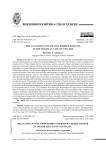
The USA's impact in solving border disputes in the Transcaucasia in 1919-1920
Статья научная
Introduction. The Transcaucasian states waged war with each other and desperately wanted to find some disinterested party to resolve their territorial disputes in 1918-1921. The territory was first occupied by the countries of the Triple Alliance, then by the Entente countries, and each of them contributed to the formation or resolution of territorial disputes. Methods and materials. Based on the historical-systemic and historical-genetic approaches, the author determines which territorial changes were proposed in the region by representatives of the United States and why. The documents collected in the State Archive of the Republic of Azerbaijan, the Archive of Political Documents of the Office of the President of the Republic of Azerbaijan, and the National Archive of Armenia were involved for analysis. Analysis. The influence of the United States on the solution of territorial issues was determined by the general approach to the territory as passing into a mandate state. During the discussion of this issue, the understanding of the American representatives about the borders of this zone expanded first from Armenia in a general sense to Transcaucasia, and then narrowed to the borders of Turkish Armenia, which brought them back to the issue of the borders of the Republic of Armenia. At the same time, representatives working in the region proposed a plan for interstate disengagement, different from the British plan, and tried to introduce a governor-general in the disputed territory. Results. The remoteness from the region, the presence of a single channel of information about it through the Armenian Diaspora in the United States affected the narrow perception of the situation in the region by American representatives. The issue of the adoption of a mandate over Armenia or Transcaucasia and Armenia somehow got connected with the issue of costs for its effective implementation. The failed attempt to create an American governor-general in the disputed territories recorded a lack of understanding of the situation in the region and the possibilities of its control and provoked more conflicts between Armenians and Azerbaijani.
Бесплатно
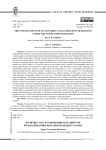
The United States policy towards UN peacekeeping operations under the Trump administration
Статья научная
Introduction. The United States has always been one of the five permanent members of the United Nations Security Council and the largest financial donor to the UN System and peacekeeping operations. American policy towards the organization and peacekeeping operations has varied from harsh critique to active support. While in the office, President Trump criticized UN PKO missions for their inefficiency and pointed out the need for reforms both in the field of peacekeeping and the entire UN system. This led some American scholars to conclude that the Trump administration was an entirely special phenomenon in American policy towards the United Nations. This article analyzes United States policy towards UN peacekeeping under the Trump administration and attempts to respond to the question: does President Trump’s policy regarding UN peacekeeping operations represent a fundamentally new phenomenon, or is it a continuation of trends that emerged during previous administrations? Methods and materials. The article analyses U.S. State Budgets, State Department Congressional Budget Justifications, official speeches by President Trump, Trump Administration foreign policy doctrine ‘America First’, official UN documents related to funding issues and troop contributions. The authors also conducted expert interviews. Analysis. President Trump administration policy towards UN peacekeeping is analyzed to identify its main trends and determine their similarities with the policies of previous presidents towards UN peace operations. Results. The article concludes that, although President Trump’s policy on UN peacekeeping operations was more critical than that of many of his predecessors, it is essentially a continuation of long-standing trends in U.S. politics. Authors’ contributions. D. Pushkina defined research focus of the article, examined academic literature on USA administrations’ policies towards the United Nations, selected research methods, defined the main vectors of the research, organized interviews with experts and made general conclusions. A. Khazanova researched and analyzed official U.S. documents with special focus on U.S. policy towards United Nations and UN peacekeeping, examined relevant UN documents, gathered budgetary data, conducted interviews with experts, made conclusions.
Бесплатно
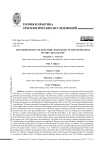
The chronology of Neolithic-Eneolithic in the steppe zone of the Volga basin
Статья научная
Introduction. The steppe zone of the Volga basin is interesting in connection with the study of the Orlovskaya, Cis-Caspian, and Khvalinskaya cultures. These cultures have an important significance for the prehistorical archaeology of Eastern Europe. The Orlovskaya culture is characterized by the appearance of the most ancient ceramics in the region, early signs of domestication are connected with the Cis-Caspian culture but the earlier metal items were found in the Khvalinskaya culture. Together with the main features of these cultures, the important question is a determination of reliable boundaries of them. From 2007 more than 60 radiocarbon dates were obtained. The basis consisted of the materials of the Varfolomeevskaya site. The most of dates had been done on the organics from ceramics. That was under dispute. Methods and materials. During the last eight years, more than 30 radiocarbon dates were obtained on the different organic materials (charcoal, animal bones, and food charred crusts) from new open stratified sites - Algay and Oroshaemoe. This set of dates gave the possibility to develop a reliable chronological schema for the Neolithic-Eneolithic in the region under consideration. The comparison of dates on the different organic materials has been done. Results. The chronological framework of the Orlovskaya culture, the Cis-Caspian culture of transition period and the Eneolithic Khvalinskaya culture for the steppe zone of the Volga basin was determined. The place of the Orlovskaya cultural antiquities among of Neolithic cultures of neighboring regions was established. The age of transitional Neolithic-Eneolithic Cis-Caspian culture with the earliest pieces of evidence of domestication in Eastern Europe was definite. The chronological framework of the Khvalinskaya Eneolithic culture in the steppe zone was considered and made the comparison with the Cis-Caspian culture. Authors’ contribution. A.A. Vybornov is prepared the archaeological part of the article and did analysis and their interpretation of the radiocarbon dates on the Neolithic of the steppe zone of the Volga basin. F.F. Giljazov collected all dates of the Orlovskaya culture of the Algay and Oroshaemoe sites. N.S. Doga did an analysis of dates of the Cis-Caspian and Khvalinskaya cultures on these sites. M.A. Kulkova obtained the radiocarbon dates for differentlayers of the Algay and Oroshaemoe sites and did the correlations on the different organic materials. B. Philippsen obtained the AMS dates on charcoal, bones, charred crusts and did their correlation.
Бесплатно
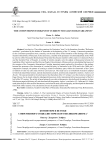
The cominternist origins of current socialist bolivarianism
Статья научная
Introduction. The article examines the Comintern “trace” in the formation of modern “Bolivarian socialism”, proclaimed by the leaders of Venezuela at the beginning of the 21st century. Communist postulates (in the Comintern perception) were, certainly, not the only source of the formation of the ideology of the ruling Socialist United Party of Venezuela. At the same time, a number of the postulates were formulated back in the 1920s by activists of the Venezuelan Revolutionary Party (later they became members of the country’s Communist Party) and the Socialist Party of Ecuador. A number of similar concepts were the subject of discussions between the leadership of the Comintern and the Peruvian People’s Revolutionary Alliance and were also debated during one of the congress of the Communist International. Another important aspect explored by the authors is the analogy between the processes of the formation of a united left party in Venezuela in the 1930s and in the 2000s (as a comparative example, the pattern of creating a united revolutionary party within the framework of the Castro revolution in Cuba was also used). Methods and materials. The study uses a set of methods of analysis adopted in historical and political science, namely documentary analysis, systemic and comparative analysis. Analysis and Results. The cases presented in the article prove that Socialism of the 21st century is not the exclusive creation of Hugo Chavez, but is closely related to ideological discussions in the international left-wing movement of the first half of the 20th century. The article is based primarily on archival documents, which allowed the authors to show little-known pages in the historyof Latin American left-wing parties. Authors’contribution . V.L. Jeifets and L.S. Jeifets made joint analysis of the archival documents, carried out the study of historiography, and developed the theoretical framework of the research. The conclusions also are the product of joint work.
Бесплатно
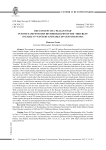
Статья научная
The concept of ‘peasant wars’ in 17th- and 18th-century Russia was borrowed by Soviet historians from Friedrich Engels’ work on the Peasant War in Germany. The four peasant wars of the early modern period were identified as the uprisings led by Ivan Bolotnikov (1606-1607), Sten’ka Razin (1667-1671), Kondratiy Bulavin (1707-1708) and Emel’ian Pugachev (1773-1775). Following a debate in the journal Voprosy istorii in 1958-1961, the ‘first peasant war’ was generally considered to encompass the period c.1603-1614 rather than simply 1606- 1607. This approach recognised the continuities in the events of the early 17th century, and it meant that the chronological span of the ‘first peasant war’ was virtually identical to that of the older concept of the ‘Time of Troubles’. By the 1970s the term, ‘civil wars of the feudal period’ (based on a quotation from Lenin) was sometimes used to define ‘peasant wars’. It was recognised by Soviet historians that these civil wars were very complex in their social composition, and that the insurgents did not exclusively (or even primarily) comprise peasants, with Cossacks playing a particularly significant role. Nevertheless the general character of the uprisings was seen as ‘anti-feudal’. From the 1980s, however, R.G. Skrynnikov and A.L. Stanislavskiy discarded the view that the events of the ‘Time of Troubles’ constituted an anti-feudal peasant war. They preferred the term ‘civil war’, and stressed vertical rather than horizontal divisions between the two armed camps. Western historians, with the notable exception of the American historian Paul Avrich, generally rejected the application of the term ‘peasant wars’ to the Russian uprisings of the early modern period, regarding them as primarily Cossack-led revolts. From the 1960s, however, Western scholars such as Teodor Shanin (following the American anthropologist Eric Wolf) began to use the term ‘peasant wars’ in relation to the role played by peasants in 20th-century revolutionary events such as those in Russia and China. Some of these Western historians, including Avrich and Wolf, used the term not only for peasant actions in the Russian revolutions of 1905 and 1917, but also for peasant rebellions against the new Bolshevik regime (such as the Makhnovshchina and the Antonovshchina ) that Soviet scholars considered to be counter-revolutionary banditry. The author argues that, in relation to the ‘Time of Troubles’ in early 20th-century Russia, the term ‘peasant war’ is not entirely suitable to describe peasant actions against the agrarian relations of the old regime in 1905 and 1917, since these were generally orderly and non-violent. The term is more appropriate for the anti-Bolshevik uprisings of armed peasant bands in 1918-1921, as suggested by the British historian Orlando Figes.
Бесплатно
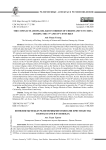
The conflicts among religious orders of Christianity in China during the 17th and 18th centuries
Статья научная
Introduction . The article studies the conflicts between the Spanish Mendicant Orders (Dominican Order, Franciscan Order, etc.) as well as the Society of Foreign Missions of Paris with Portuguese Society of Jesus, which took place during the 17th and 18th centuries in China. Methods and materials. To studythis issue, the author used the original historical materials recorded by Western missionaries working in China during the 17th and 18th centuries and research works by Chinese and international scholars related to the Chinese Rites Controversy as well as the process of introduction and development of Christianityin this country during the 17th and 18th centuries. The author combines two main research methods of History Science (historical and logical methods) with other research methods (systemic approach, analysis, synthesis, comparison, etc.) to complete the study of this issue. Analysis. In the 17th and 18th centuries, the struggle for faith of the peoples in the Far East, especially China, became the desirable goal of religious orders of Christianity. Therefore, during this period, Western missionaries belonging to various religious orders of Christianity, such as the Society of Jesus, Mendicant Orders, Society of Foreign Missions of Paris, etc., gradually entered this country. In the course of evangelization, the struggle for influence as well as the right to manage missionary affairs in China at that time created conflicts among Christian religious orders. It is manifested in the form of a debate about Chinese rituals. In fact, these conflicts not only caused great losses to the missionary career of contemporary Christian religious orders taking place in China but also made the relationship between China’s ruling authorities and The Holy See became very tense. Results. Based on the study of the conflicts among religious orders of Christianity in China during the 17th and 18th centuries, the article clarifies characteristics, the root and direct causes leading to this phenomenon, making a certain contribution to the study of the relationship among religious orders in the process of introduction and development of Christianity in China in particular and the history of East-West cultural exchange in this country in general in the 17th and 18th centuries.
Бесплатно
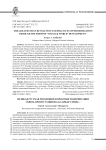
Статья научная
Introduction. There is a scientific, theoretical and practical necessity to understand modern phenomena of revolution and modernization. The political analysis of the influence of revolutionary events and modernization changes on the development of the Cossacks, not only as an ethnic community and social group, but as a kind of “world” that is currently undergoing a revival process, is of particular interest. Methods and materials. The paper relies on theoretical conclusions of researchers who specialize in the field of the theory of social change and development, political transitology, global studies, ensuring national and global security. Analysis. This paper presents the scientific analysis of socio-political practices of transformation of the Russian state and society in the historical perspective. The interrelation between the revolutionary events in Russia at the beginning of the 20th century and the contemporary stage of the national modernization are traced. The author interprets the results of a survey devoted to public opinion of Russians regarding the causes and significance of the revolutionary process of 1917. The paper is focused on the correlation between “revolution” and “modernization” phenomena in the context of setting and achieving goals, tasks, using various technologies of social change. Results. The author characterizes the influence of modernization transformations on life activities of the ethnic community- the Cossacks. The article identifies the problematic aspects of the Cossacks' “revival” at the present stage of the socio-political modernization of Russia. The author proposes the integrative concept of the etatist model of the political modernization of Russia considering the parameters of stable and safe development.
Бесплатно
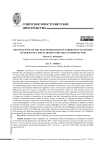
Статья научная
Introduction. The article outlines transformations in Uzbekistan’s economy during the Great Patriotic War, the emergence of problems related to personnel as a result of these changes, the main causes of the lack of staff, and measures to prevent this shortage and their effectiveness. The given study analyzed the organizational problems of providing the economy with employees, analyzed measures taken during the Great Patriotic War to meet the demands of the country’s economy for personnel, and obtained new data dealing with the social status of human resources. Methods and Materials. A wide range of archival sources from the funds of the National Archive of Uzbekistan that weren’t published earlier was used in the preparation of the article. The methodological basis of the research is the principle of historicism. In the course of the study, historical-comparative and statistical methods were applied. Analysis. The research conducted identified factors related to productivity and social issues. In particular, the labor productivity of the new staff (mainly women and adolescents) replacing qualified personnel who went to the war front has been analyzed; on the other hand, the impact of the working process on their social lives has been considered. During the war years, the involvement of women and children in production in the republic and their relationship with the evacuated population resulted in significant positive trends in society. Results. In general, by studying the impact of changes in Uzbekistan’s economy on personnel issues during the Great Patriotic War, valuable information about various sectors of the Republic’s economy during the war years as well as the advances and defects in different economic branches was obtained. Authors’ contribution. Kh.B. Babadjanov and A.K. Abdullayev jointly studied archival materials and scientific literature and drew conclusions on the topic. Kh.B. Babadjanov analyzed the documents of the National Archive of Uzbekistan, which made it possible to explore the peculiarities of the transformation of the economy of Uzbekistan during the Great Patriotic War and the supply of it with personnel. A.K. Abdullayev participated in the analysis of statistical and economic data.
Бесплатно
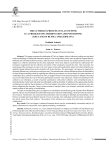
Статья научная
This paper examines the celebration of The Last Supper in three Lutheran worship services based on the methodology of multimodal interaction analysis. The corresponding videos were recorded in Sarepta (Russia), Rimbach and Zotzenbach (both Germany). After the review of relevant research, the analytical interest in the Last Supper as a collective positional task has been explained. Three-case analyses reconstruct the architecture-forinteraction requirements for the collective movement of the community towards the altar. This movement, the positioning of the community to receive The Last Supper (wine and bread) and the return to the church benches are spatially related subtasks that need to be dealt with in the situation. The community’s movement is organised in obviously different ways in the three worship services. The reconstruction of these differences allows the formulation of three divergent models primarily regarding the following two aspects: on the one hand, the extent and form of socialisation (as a symbolic re-enactment of The Last Supper of Jesus Christ and his disciples on Maundy Thursday) and, on the other hand, the way in which the participants consume wine and bread. A model of socialisation with collective care (Sarepta), a model of partial socialisation with partial collective care (Zotzenbach) and an individualisation model with individual care (Rimbach) could be identified. In addition to the opportunities that the architecture provides for the performance of The Last Supper, the number of participants in particular was a key factor influencing the structure. Once a certain number is reached, there is an economic constraint which has a negative effect on the quality of socialisation. The idea of conceptualising the Last Supper as a coordination and positioning task originates from Reinhold Schmitt. He has also developed the multimodal interaction-analytical methodology, which provides the basis for this research. Furthermore, he created and transcribed the video recordings in Rimbach and Zotzenbach. Anna Petrova recorded and transcribed the church services in Sarepta. The methodical and theoretical conception of the article comes from both authors. The analyses of the selected case studies have also been conducted in collaboration.
Бесплатно
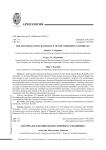
The materials for craniology of the northern samodians
Статья научная
A small sample of paleoanthropological materials from the burial grounds Buchta Nakhodka 2 and Yumadoto 1 in the Yamal Peninsula (Yamal district of Yamalo-Nenets Autonomous Okrug of Tyumen Region) has been studied in order to specify the nature of intra-group and inter-population variability. The morphological features of the skulls indicate their belonging to the eastern Mongoloid anthropological formation, but in terms of the nasal bridge structure, they at the same time tend to the western Caucasoid population. According to the results of multidimensional statistics, despite a high individual variability typical of the modern species of Homo sapiens, the range of variability observed in the materials from the burial grounds Buchta Nakhodka 2 and Yumadoto 1 is not beyond the scope of the inter-group variability typical of the Northern Samodians. A more representative sample of this ethnic group has been formed on this basis, which is taxonomically included in the Yamalo-Enisey group of populations of the West Siberian anthropological formation. Authors' contribution: A.N. Bagashev and S.M. Slepchenko have made measurements of skulls, analyzed the obtained data and have written the paper; O.V. Kardash has carried out archaeological excavations of the burial ground Bukhta Nakhodka 2 and has co-written the paper.
Бесплатно
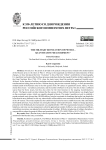
The military revolution of Peter I - quantitative measurement
Статья научная
Introduction. The article is devoted to the analysis of the processes related to the modernization of the Russian army in the times of Peter I. Owing to the magnitude and historical momentousness of these changes, we have introduced the term “revolution” in lieu of the term “reform” used hitherto in historiography. It is significant and noteworthy that these processes took place during the regular frontline military operations of the Great Northern War (1700-1721), when the tsarist army faced the perfectly organized Swedish army. Methods. So far, theories of military revolution and neo-institutional revolution have been deployed to show the transformations taking place at the time. Without denying the previous research findings, we have presented the modernization of the Russian army in the first quarter of the 18th century in quantitative terms. Hence, we have chosen three issues - recruitment, armament, and the number of officers in the army. Not only is there a sufficient source base for these issues, but they also allow for the time function in the ongoing transformations. Results. The figures under scrutiny indicate that the success of these military transformations was largely based on the recruitment system, which was superbly adapted in Russia. This made it possible not only to establish a regular national army of more than 100,000 soldiers, but also to maintain its headcount during the war despite the losses that the army suffered. In this way, almost half a million soldiers were recruited in Russia in the first quarter of the 18th century. The article emphasizes the conditions that had to be met to establish an army that could match the Swedish adversary. A key element was arming the military with modern firearms. Thanks to foreign purchases, primarilyin the Netherlands, the rearmament was completed before 1709. The organizational structure of regiments, battalions, and rotas was also reorganized, so that the appropriate number of officers, non-commissioned officers, and military musicians was adjusted to the total number of soldiers. With the introduction of military discipline, it was possible to reduce the group of officers and musicians from 18.25% (1699/1700) to 10.15% (1711).
Бесплатно
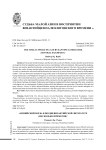
The mysian spoils in late byzantine literature (several examples)
Статья научная
The ancient Greek literature used the term Mysian Spoils (Μυσ§ν λεßα) to describe some territories or properties that the neighboring and enemy armies could plunder without retaliation. More generally speaking, the term was used to describe the plunder, enslavement, and hardship in general. The term Mysian Spoils could be found in the works of many ancient authors, and it also became part of the rich collection of Old Greek proverbs. As such, it continued to exist and could be found in the vast array of various forms of expression by the Byzantine authors. This text showcases examples of usage of this term in the historical works by the Late Byzantine authors George Pachymeres and Nikephoros Gregoras, as well as the examples from the satirical text Mazaris’ Journey to Hades. The mentioned historians used the term Mysian Spoils quite appropriately, being aware that well-trained readers will not only understand the meaning of this expression, but also appreciate their own scientific knowledge of the literary heritage of antiquity. Pachymeres and Gregoras emphasized the basic meaning of the term, sometimes with elegant wit, as a designation of robbery, before which the defenders were powerless. The author of the satirical essay Mazaris’ Journey to Hades advanced further, turning the expression Mysian Spoils into the metaphor of a disease that beats the mortal body of the satire hero, with the typical color of a writer.
Бесплатно
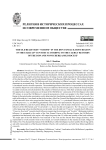
Статья научная
Introduction. This article represents an analysis of the state of the Old Believers’ “schism” in the Don Cossack Host Region (Province or Oblast ) in the early 20th century: determining the Old Believers’ concords existing in the region, as well as their numbers and localization. Methods and materials. The empirical base of this article consists of a complex of archival documents, the clergy records, which represent the clerical documentation of the churches of the Don and Novocherkassk Diocese of the Russian Orthodox Church. The member churches, as well as the numbers of the Old Believers and their belonging to different concords, were recorded in those documents on an annual basis. This is the first time that the statistical component of the complex of those sources is introduced into the scientific operation. The methodological base of this article is represented by the principles of scientific objectivism and systematicity, which are traditional for historical science. Based on those principles, we could reveal and correctly determine the complex of historical sources, while their systematic study provided the opportunity to make conclusions on the state of the Old Believers’ community of the Don Region in the early 20th century, to reveal the Old Believers’ concords (persuasions), which were popular in the Don Cossack Host Region in the period under examination, and to determine their localization peculiarities). Analysis and results. As a result of the analysis, it was found out that in the territory of the Don Cossack Host Region there lived representatives of both concords: those who recognized the hierarchy (“ Popovtsy ”, i.e. priesthood followers) and those who did not (“ Bespopovtsy ”, i.e. not following priesthood). The former were represented by “ Beglopopovtsy ”, i.e. fugitive priesthood followers, and the Austrian (Belaya Krinitsa) concord, with the latter divided into “ Okruzhniki ”, i.e. followers of the 1862 Epistle, and “ Neokruzhniki ”, i.e. those who did not recognize it. The “ Bespopovtsy ”, along with a large group whose membership was not provided, were divided into “ Pomortsy ” (coastal church followers), “ Pomortsy-Brachniki ” (coastal church followers recognizing the marriage), and “ Sredniki ” (Wednesday tradition followers. As compared to the results of the First General Census of the Russian Empire, the Old Believers’ population had decreased in the region, still comprising more than 5% of the total number of the local residents. The major part of the Old Believers was localized in the First and the Second Don Okrugs (districts). Most representatives of all concords lived in the Cossack yurt (small settlement) in the stanitsa (Cossack village) of Nizhny Chir. The characteristic feature of the Old Believers of the Don Region was their conflict-free living side by side with representatives of the Russian Orthodox Church, with co-believers, and with those following different concords.
Бесплатно
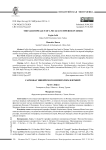
The sarcophagus of a Nicaean emperor in Izmir
Статья научная
In this brief paper a marble slab fragment from Izmir in Western Turkey is presented. Originallyits description was published by Ch. Texier in 1844 and later deemed missing. We believe that it is an imperial sarcophagus and that it may belong to the emperor of Nicaea, Theodore II Lascaris.
Бесплатно
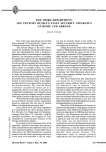
The third department: 19th century Russia's state security apparatus at home and abroad
Другой
Бесплатно
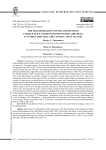
Статья научная
Introduction. The paper describes aspects of the transformation of neo-Ottomanism under Justice and Development Party (JDP) rule in Turkey (2002-2022), with a focus on the situation in Central Asia. Methods and materials. The article employs the case study method and examines the Central Asian vector of Turkish foreign policy from 2002 to 2022. Analysis. Since the collapse of the Soviet Union, filling the political power void in Central Asia has been one of Turkey’s key foreign policy interests. This interest was reinvigorated by the domestic political transformation in light of the accession of the Justice and Development Partyin 2002. The neo-Ottomanism that formed the basis of JDP’s foreign policy, on the one hand, elaborated on the Ottomanism of the last century and, on the other hand, mirrored the changes in the political system of the country after 2013, such as the authoritarianization of the ruling regime and the rise of Islam as a tool for public support consolidation. Results. As a result, the conclusion was drawn that over the past twenty years, neo-Ottomanism has come to represent a broadly circumscribed liberal economic approach combined with an appeal not only to the common Ottoman past and pan-Turkic sentiments but also to the Muslim present. Meanwhile, Turkey’s cultural and religious rapprochement with the region is driven by its strategic economic interests, for which Central Asia is an integral component of Turkey’s new international role. Thus, Turkey’s policy towards Central Asian states reverberates the outcome of the transformation of the neo-Ottoman discourse as a product of the country’s changing domestic political landscape while shedding light on the strategic priorities it encompasses: becoming a regional hub and a proactive regional power. Authors’ contributions. T.V. Marmontova - preparation of the structure of the article, methodology, and review of literature, M.B. Zhiyenbayev - “Regionalization” of foreign policy of Turkey and the place of Central Asia in the pan-Turkic picture of the world, E.A. Vaseneva - assessment of the policyof the Justice and Development Partyin Turkey in 2002-2022.
Бесплатно
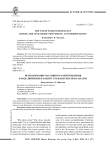
The use of passive resistance during the civil rights movement: an interpretation
Статья научная
The roots of nonviolent direct action and the development into a powerful method of persuasion and coercion will be explored in an attempt to explain its distinctive role in the Civil Rights Movement. The paper will focus on the participation of the three actions, the political, the legal and the passive, in the victorious moments of the Movement.
Бесплатно
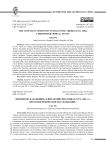
The venetian community in byzantine Thebes (1072-1204): a prosopographical study
Статья научная
Thebes is among the best-documented Venetian colonies in Byzantium, with records dating back to 1072. While it is widely acknowledged that Venetians played a crucial role in the development of Byzantine Thebes, the details about the Venetian community of the city remain largely unexplored, which has hindered a deeper understanding of the true extent of the Venetian impact on Thebes. To address this scholarly gap, the article examines the community using Venetian documentary sources, focusing on the works of R. Morozzo della Rocca and A. Lombardo. The study adopted a prosopography methodology, reconstructing and analysing the biographies of individuals and families in groups. The investigation covers the community’s leading families and individuals, as well as clergy and ecclesiastical establishments of special interest. Following this vein, the author of the article concludes with a more detailed picture of the Venetian community. It seems to have played a notable and persistent role in Thebes. Ecclesiastical establishments and the clergy constituted the basis of Venetian activities. Bolstered by reliable and sustainable sources of income, these institutions fulfilled the basic religious and administrative needs of the Venetian community. Apart from possible industrial and agricultural engagements, the community members predominantly emerge as active participants in commercial ventures, linking in particular to the renowned Theban silk textiles. While Venetians did form matrimonial and commercial alliances amongst themselves, their assimilation with the native Byzantine populace of the city seems to have been minimal.
Бесплатно

